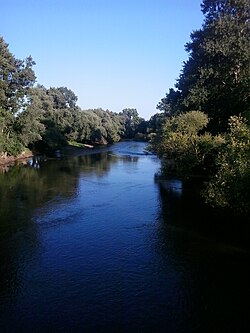Top Qs
Timeline
Chat
Perspective
Sajó
River in Slovakia and Hungary From Wikipedia, the free encyclopedia
Remove ads
The Sajó (Hungarian pronunciation: [ˈʃɒjoː] SHOH-yoe, Hungarian) or Slaná (Slovak) is a river in Slovakia and Hungary.
This article needs additional citations for verification. (February 2018) |
Its length is 229 km, of which 110 km is in Slovakia. Its source is in the Stolica Mountains range of the Slovak Ore Mountains. It flows through the Slovak town Rožňava and the Hungarian city Miskolc. In Hungary Sajó flows through the county of Borsod-Abaúj-Zemplén. It flows into the River Tisza near Tiszaújváros. Its main tributaries are the Bodva and the Hornád. It is also known for the Battle of the Sajó River from 11 April 1241 between the Mongol Empire and the Kingdom of Hungary.
Remove ads
Geography
Catchment area of the Sajó river by country:[3]
Important hydrological stations along the Sajó river:[3][2]
Remove ads
Tributaries
Summarize
Perspective
Complete list of streams (slovak 'potok'; Hungarian 'patak') and rivers flowing into the Sajó (from the estuary upwards):[2][4][1]
Remove ads
Etymology
The origin of the name is the subject of scholarly discussions. Hungarian linguists and historians suggested the derivation from the Hungarian sojó, só folyó (salt water, river) already in the 19th century.[5] Newer theories associate the name with sió referring to fast streams. According to Slovak linguists, the name is pre-Hungarian (Slaná: salt river) and most likely not associated with the salinity but with the salt road existing already in times of Great Moravia. The supporters argue by citing numerous Slavic toponyms in the river basin and by local names related to soľ (salt) and Moravia like Moravce, Soľár, Solišče, Soľka, Soľník, Morava (according to this interpretation the Hungarian name is a later translation).[6]
References
Wikiwand - on
Seamless Wikipedia browsing. On steroids.
Remove ads



